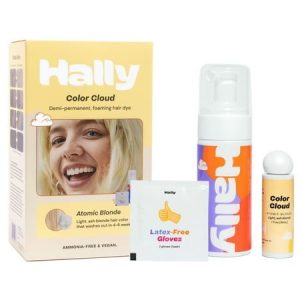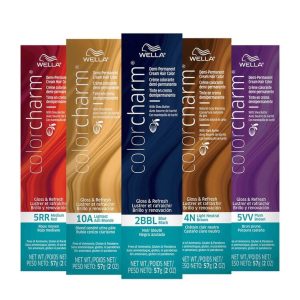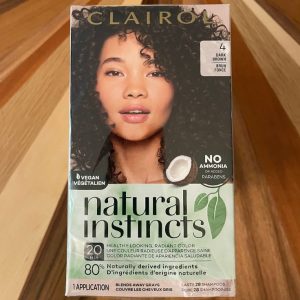Demi-permanent hair dye offers a tempting option for those who want to change their hair color without a long-term commitment. But a common question arises: is demi-permanent hair dye damaging?
This article dives into the world of demi-permanent dyes, exploring how they work, the potential effects on hair health, and tips for minimizing damage.
What is Demi-Permanent Hair Dye?
Unlike permanent hair dye, which lifts and deposits color, demi-permanent hair dye only deposits color. It lacks the ammonia or harsh chemicals found in permanent dyes. These chemicals can lift the hair cuticle, allowing for deeper color penetration but also potentially causing damage.
Demi-permanent dyes typically contain lower levels of peroxide, which helps the color adhere to the hair strand. Peroxide can lighten hair slightly and open the hair cuticle a bit, but not to the same extent as permanent dyes.
How Does Demi-Permanent Hair Dye Affect Hair?
Since demi-permanent dyes don’t contain harsh chemicals, they are generally considered less damaging than permanent dyes. However, they can still have some effects on hair health. Here’s a closer look:
Color Fading:
Demi-permanent dyes deposit color on the hair shaft, but they don’t penetrate deeply. This means the color can fade gradually over time, especially with frequent shampooing or sun exposure.
Drying Effects:
Some demi-permanent dyes, particularly those containing alcohol, can be drying to hair. This can lead to frizziness or breakage. However, many demi-permanent dyes now contain conditioning ingredients to counteract this effect.
Build-up:
While less likely than with permanent dyes, some demi-permanent dyes can cause color build-up over time. This can make hair appear dull or unevenly colored.

Minimizing Damage from Demi-Permanent Dyes
Here are some tips to minimize any potential damage from demi-permanent hair dye:
-
Choose a reputable brand: Look for demi-permanent dyes formulated with conditioning ingredients and lower levels of peroxide.
-
Healthy Hair Starts with You: Maintain healthy hair with regular trims, deep conditioning treatments, and using heat styling tools on low heat settings.
-
Post-Dye Care: Use color-safe shampoos and conditioners to help protect the new color and keep hair hydrated.
-
Less is More: Start with a shorter processing time and see if you achieve the desired color. You can always apply the dye for more intensity.
-
Consult a Stylist: If you have concerns about your hair health or color choices, consult a professional hairstylist. They can assess your hair and recommend the best demi-permanent dye option for you.
Demi-Permanent Hair Dye: A More Gentle Option
Overall, demi-permanent hair dye offers a gentler alternative to permanent dyes. While it can have some effects on hair, these are generally less severe and can be managed with proper care. For those seeking a temporary hair color change with less commitment, demi-permanent dye can be a good choice.
When deciding if demi-permanent dye is right for you, consider your hair health and desired outcome. If you have concerns, consult a professional. With proper care, demi-permanent dye can be a fun way to experiment with color without major damage.

Demi-Permanent Dye and Color Vibrancy
Another factor to consider with demi-permanent dyes is color vibrancy. Because they deposit color on top of the hair shaft rather than penetrating it, demi-permanent dyes may not achieve as dramatic a color change as permanent dyes, especially on darker hair.
Here’s a breakdown:
-
Lighter Hair: Demi-permanent dyes can add subtle color enhancements or richer tones to lighter hair colors. They can also be effective for refreshing highlights or adding dimension.
-
Darker Hair: For darker hair, demi-permanent dyes may only deposit a slight tint or add a touch of shine. They won’t lighten hair significantly.
Alternatives to Demi-Permanent Dye
If you’re looking for a temporary color change but are concerned about any potential effects on your hair, there are some alternatives to consider:
-
Hair Color Gels and Mousses: These temporary color options typically wash out after one shampoo. They come in a wide range of colors and can be a fun way to experiment with color without commitment.
-
Hair Mascara: Similar to mascara for lashes, hair mascara comes in various colors and allows you to add temporary highlights or streaks.
-
Colored Hair Sprays: Temporary colored hair sprays are another fun way to add a pop of color to your hair. They wash out easily and come in a variety of vibrant shades.
Demi-Permanent Dye and Hair Type
How demi-permanent dye affects your hair can also depend on your hair type. Here’s a quick look:
-
Virgin Hair: Hair that has never been colored is generally the healthiest canvas for any dye. Demi-permanent dyes are less likely to cause damage on virgin hair.
-
Colored Hair: If your hair is already colored, especially with permanent dye, demi-permanent dye may interact differently. Consult a hairstylist to understand how the demi-permanent dye might affect your existing color.
-
Porous Hair: Hair that is porous (easily absorbs moisture) may absorb demi-permanent dye more readily. This can lead to a more intense color payoff but may also make the color fade faster.
-
Chemically Treated Hair: Hair that has undergone chemical treatments like straightening or relaxing may be more susceptible to damage from any dye, including demi-permanent.
Maintaining Hair Health After Demi-Permanent Dye
Regardless of hair type, here are some general tips to maintain hair health after using hair dye:
-
Deep Conditioning: Regularly deep condition your hair to replenish moisture and prevent dryness.
-
Heat Styling Minimization: Limit your use of heat styling tools like straighteners and curling irons. When you do use them, apply a heat protectant spray beforehand.
-
Sun Protection: Just like skin, hair can be damaged by UV rays. Use a leave-in conditioner with SPF or wear hats to protect your hair from the sun.
-
Trims: Regular trims help remove split ends and keep hair healthy-looking.

Conclusion: Choosing the Right Hair Color Option
Ultimately, the best hair color option for you depends on your desired outcome, hair health, and comfort level with potential effects. Demi-permanent dye offers a good balance between temporary color and minimal damage. However, temporary color options like gels, mousses, sprays, and mascaras can provide a way to change your hair color without any lasting effects.
Consider your hair goals and consult a professional hairstylist if you have any questions or concerns. They can help you choose the best hair color option for you.


